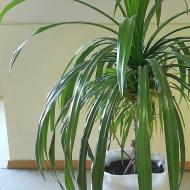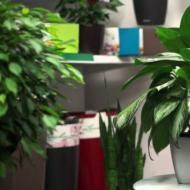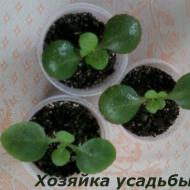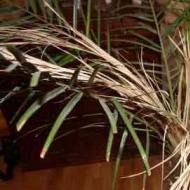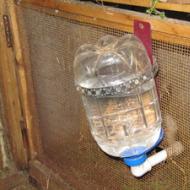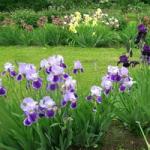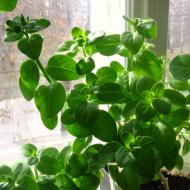
Houseplants in dry air. What flowers can be grown without sunlight? And desert stars...
Eco-friendly home: There are quite a lot of such low-maintenance indoor plants; it’s easy to choose hanging or beautifully flowering, large or miniature...
Plants for the lazy person
Beautiful, well-groomed green plants decorate the house, saturate the air with phytoncides, absorb harmful substances and create an atmosphere of comfort. But in order for store-bought potted flowers to grow and develop safely in your apartment, you need to take care of them.
Some capricious green creatures need to be sprayed with water mist 3-4 times a day, others need shading from the bright sun at noon and lighting in the evening. People who work outside the home and often go on vacation or on business trips cannot provide such plants with normal care.
So, can we do without greens entirely? No, you just need to choose the most unpretentious indoor plants for landscaping your home. Those that can withstand 1-2 weeks without watering, grow well in the dry air of a heated apartment, feel normal both in the heat and in a cold draft, and do not require frequent feeding and replanting.
1. It is probably difficult to find a more unpretentious indoor plant than Sansevieria (mother-in-law's tongue, pike tail) . It grows well both on a south window and in a semi-dark corner, but on a sunny window the leaves will be brighter.
You can replant it every few years when it doesn’t fit in the pot. No need to feed.
Sansevieria does not suffer from the dry air of the apartment in winter; it does not need to be sprayed. It is necessary to water rarely - the dense leathery leaves retain a supply of moisture, in winter you don’t have to water it at all - growth will stop, and it will rest until spring.
Cold drafts of sansevieria are not scary; it often decorates cold foyers and hallways.
2. Another exceptionally persistent hanging plant - Hoya carnosa or "wax ivy". It grows well on the south window, and it won’t go to waste in the north room either. Its thick waxy leaves accumulate moisture, and it can easily survive several months without watering.
If you managed to completely dry out your hoya and it has lost all its leaves and roots, cut the stalk from the stem and place it in water - in a couple of weeks the plant will sprout roots again.
Wax ivy is replanted very rarely, when there is absolutely no room in the pot. You can also do without fertilizing. And under good maintenance conditions, unpretentious hoya will delight you with abundant and lush flowering.
3. Indoor plant is very popular crassula oval , better known as Crassula or "money tree" . It needs to be watered rarely - the fleshy leaves retain a lot of moisture. Dry apartment air does not harm the fat woman. It practically does not need fertilizing and replanting.
The money tree can grow on the south window and on the north. Can be kept in a cool room in winter at temperatures up to 10 degrees.
You just need to follow two simple rules for caring for your money tree: the pot is small so that the soil has time to dry between waterings, and add more sand, perlite or vermiculite to the soil mixture.
It reproduces easily - just stick a leaf into the ground or water.
4. Graceful green or white-green narrow leaves chlorophytum seem tender and brittle. But this plant is one of the most undemanding and easy to care for. Its underground part has thickenings that accumulate water and nutrients.
Chlorophytum is not afraid of drought and excess moisture, heat and cold drafts; it can grow in the sun and in the shade. It can live in one pot for many years (it’s better, of course, to replant it on time, but it won’t go away without replanting and fertilizing).
Chlorophytum is considered one of the best absorbers of harmful substances from the air. Perhaps the reason the plant is able to survive without proper care is because it can obtain and process the substances it needs from the air.
5. Aspidistra also does not require special care. This plant in England is called the "cast iron plant" for its ability to withstand heat and cold, lack of light and moisture. Its other name is “friendly family” because of the large number of leaves on long petioles growing from a small pot.
This plant is ideal:
- for northern rooms,
- for decorating rooms with insufficient daylight,
- for landscaping offices with artificial lighting.
Aspidistra grows normally in dry and humid air, is not afraid of drafts or heat, and does not suffer from excess or lack of moisture. It needs to be replanted rarely, when the rhizome begins to occupy almost the entire pot.
6. Exotic doesn’t need special care either. zamioculcas. Tolerates poor lighting and interruptions in soil watering. Zamiakulkas does not suffer from bright sun, does not require frequent replanting and fertilizing, and grows well in a small pot.
If you do not water for a long time, it will shed all the leaf blades and lose its decorative appearance, but new complex leaves will quickly grow from the tuber (thickened stem under the surface of the soil) after watering.
The only requirement– the soil should not be too nutritious and dense. It is better to mix ready-made soil for violets or cacti with sand.
7. An ideal plant for people who often leave their home for 1-2 weeks - nolina (bocarnea) . This desert dweller with a bottle-shaped trunk looks original in any interior and requires very little care and attention. And to form a caudex (thickening on the trunk), it needs to be watered rarely, but abundantly, so that it is saturated with water during the “drought” period.
The only requirement– to plant bokarnia correctly: the soil should be loose, low in nutrition, the pot should be small. After a good watering, all excess moisture should drain out of the pot. This plant will rot in wet soil.
8. Scindapsus aureus - an unpretentious hanging plant with heart-shaped or rounded leaves of bright green color with yellowish-white spots. The plant can reach one and a half meters in length and is used for vertical gardening.
Scindapsus is quite shade-tolerant and can grow in the back of the room., where the sun only occasionally hits, or even gets by with only artificial lighting. True, leaves in the shade lose their light spots and become completely green.
Plant care is minimal. Scindapsus effectively purifies the air of harmful substances. Feels very good in the kitchen, where there are constant changes in temperature and humidity. Its dense leaves and stems retain moisture well. It grows quickly, so it is advisable to fertilize it periodically.
9. Some types Kalanchoe have long been known as a medicinal houseplant that does not require any care. Recently, many beautifully flowering Kalanchoe hybrids have appeared.
The plant can be watered rarely; its dense, succulent leaves and stems contain a lot of moisture. Grows well on windows of any orientation.
Kalanchoe is a shade-tolerant flower, It tolerates sudden temperature changes without problems and blooms for a long time. It grows quite slowly and does not need frequent replanting.
10. Spathiphyllum - an unpretentious plant that blooms throughout the year. In summer it grows well on western, eastern and northern windows; in winter it is better to move it to the southern one.
It tolerates a lack of moisture well. If the leaves become too dry, they droop, but after watering they come back to life. Does not require frequent transplants. Fertilizers are useful, but without them they will not be lost.
For spathiphyllum, it is important to choose the right place - it does not like the cold. Place it away from drafts and windows that open in winter for ventilation, and there will be no problems with the plant.
There are quite a lot of such low-maintenance indoor plants; it’s easy to choose a hanging or beautifully flowering one, large or miniature. Minimal care does not mean that a flower can be left in a corner for six months without watering. Each indoor plant requires attention; it responds to care with new shoots and the appearance of buds.
Unpretentious, easy-to-maintain home flowers are perfect for beginning gardeners.
In flower shops, customers are often asked to choose unpretentious indoor plants that require a minimum of care and provide maximum pleasure. Some have already had a sad experience with dried flowers, while others are just about to decorate their home or office and already feel responsible. Sellers are sure to find suitable specimens of persistent plants that are able to bloom even in insufficient lighting, irregular watering and the absence of mineral fertilizing. We suggest you go through the list.
1. Geranium
This plant is planted in the house and in front gardens; it feels comfortable everywhere. Among the diverse varieties of geraniums there are light-loving and shade-loving, drought-resistant. At home, she feels great at room temperature and bright light. There are no special requirements for the soil, but it needs to be watered regularly, focusing on the moisture content of the earthen clod. In winter, the frequency of watering can be reduced, since the plant is usually dormant.
2. Tolmia Menzies
This easy-to-grow plant will delight you with its unusual ability - the appearance of young leaves next to the adult leaf. In order for the Menzies tolmia to please for a long time, it is necessary to provide it with an ambient temperature within 15–18 degrees, and keep it away from heating systems in winter. Regular watering is needed: in the summer twice a week, in the winter - once every two weeks. Tolerates bright diffused light and partial shade well.
3. Howea Forstera (kentia)
Despite the fact that the subtropical palm was brought from the coast of Australia, it has taken root well in our apartments and has become one of the most shade-tolerant plants. She will be quite happy with the northern and northeastern sides. Tolerates dry air and significant temperature drops well. Therefore, it can often be found in offices. You need to water moderately, focusing on the condition of the top layer of soil - whether it has dried out or not. The plant will signal a lack or excess of moisture in the pot by the appearance of the leaves - large brown spots may appear on them. Healthy leaves love to shower.
4. Syngonium
The graceful shape of the leaf and the unusual color of the syngonium attract the attention of flower growers, who also love this plant for its simple and easy care. The plant tolerates partial shade and diffused light well, but in winter it is better to keep it close to natural light so that the leaves retain their color saturation. Loves humidified air and a temperature of about 20 degrees. If you wipe the leaves with a soft sponge in the heat, the syngonium will be grateful for such a gift.
5. Peperomia silver
Looking at the fancy leaves of this plant, you just want to smile - how similar they are to a watermelon! If you start silver peperomia at home, you are guaranteed a good mood. Especially if you provide her with more or less suitable care: bright diffused light or partial shade, a temperature within 20 degrees, moderate humidity and moderate watering based on the condition of the soil, especially in winter.
6. Chlorophytum crested
A good option for use in hanging flowerpots. Easy to care for, resistant to diseases, tolerant of temperature changes. Irregular watering will not affect its condition. For chlorophytum, you do not need to worry about saturated soil and abundant fertilizer, a large pot and bright light. All this is enough in moderation and with a reasonable approach. Will be grateful for frequent spraying in the summer.
7. Gasteria
The plant got its name from the tube-shaped compaction in the lower part of the perianth, which in Latin sounds like “gasltron”, and is translated as “pot-bellied vessel”. To fill this vessel, it is not necessary to water the flower abundantly; it is enough to keep the soil moist. In winter, you can water once or twice a month. But she would like more light, although she does not like direct sunlight. Then it's better to go into the shade. Doesn't like drafts, but won't refuse ventilation.
8. Ficus rubber
Only in our latitudes is ficus considered an ornamental houseplant, but in its homeland in the tropics it is a tree from which rubber is extracted. But family ties are strong, so the plant loves warmth and a lot of light, preferably diffused. Does not like drafts and waterlogging of the soil. It will be grateful for spraying in rooms with dry air and wiping the leaves with a damp sponge.
9. Araucaria variegata (Norfolk pine)
Do you want to have a Christmas tree in your home? Buy araucaria. The evergreen plant is very easy to care for. It can grow in the coolest room, and in summer - in the partial shade of an open balcony. If the air is dry, then it would be good to take care of spraying and regularly moistening the soil. It is better to water and spray with soft water at room temperature.
10. Mirsina
Modest care requirements are a distinctive feature of this indoor tree. You just need to place it in a bright room, but not in direct sunlight, and also provide it with watering and spraying. The soil should be breathable; you can select it yourself from equal parts of garden soil, humus, sand, or buy a ready-made mixture.
11. Crassula (money tree)
Apparently, the shiny, fleshy leaves of the plant evoke an association with coins, which is why the second name for the crassula is firmly established - money tree. But even if you don’t get hung up on this, the simplest care will keep the plant blooming and the greens juicy. It is important not to overdo it with watering and not to replant the flower often and into a large pot. It is necessary to fertilize only in the summer with special fertilizers. He loves diffused sunlight - this is due to his African roots.
12. Ceropegia Vuda
Even if you have not watered the plant regularly and never fed it, it will still please you with flowering in early summer. This is the only reason why you can love Wood's ceropegia. She also feels good in conditions of high and low temperatures, on southern and northern sides. The only point that should be taken into account for a hanging plant is to hang the pot higher, as growth can be fast and lush.
13. Aloe
Tree aloe is the most common and most familiar representative of the genus of succulent plants. Most often, it is bred for medicinal purposes because of its fleshy leaves, the contents of which are used both in folk and traditional medicine. This plant is able to survive in extreme climatic conditions, which is why it has survived to this day. This means it will survive your departure.
There are about 500 species of aloe in nature, and there are very beautiful specimens, so don’t be lazy to look for the one you like best. So that the money for a flower does not end up being wasted, still try to pay attention to it. Care is simple: in summer you need to water the plant once a week, in winter - once a month, you can focus on dry soil in a pot. Replanting in special soil for succulents is enough once every two years. The flower tolerates shade better than the scorching rays of the sun.
14. Kalanchoe
The parade of unpretentious succulent plants will continue with Kalanchoe, which is also known for its medicinal and decorative properties. Of the two hundred species growing in tropical zones, several dozen fall into the category of our indoor plants. You are guaranteed to be able to choose your Kalanchoe and make friends with it, even if you pay minimal attention to it. The plant will better withstand drought in its pot than a flood at your mercy. Feels good in a cool room and does not like to be under the scorching sun, although it prefers light.
15. Echeveria (echeveria)
This flower from the genus of succulents is also called “stone rose” due to its external similarity. The plant is easy to grow as it does not require special conditions. You can use clay-sandy soil, if you have one in your area, or buy a special mixture for succulents. It does not like water to stagnate in the pot, so even in summer it is better to reduce watering if the soil is still wet. In winter, you can completely avoid watering for a month. With sufficient light, expect flowering in spring or early fall.
16 . Godson Rowley
Due to the unusual shape of the leaves, this succulent was called “strings of pearls”. Their thick skin was formed in the process of adaptation to the harsh conditions of arid Africa. This means it will survive in your conditions. For a beginning florist, ragwort is just a godsend. You can not water it for a long time, put it on the shady side or on the sunny side, dry the air in the room or overcool it. He will silently endure all experiments, reacting to them only with the size of pea-sized leaves and more elongated weakened stems.
17. Sedum Morgana
The following plant with unusual hanging stems may become your favorite not so much because of its appearance, but because of its unpretentiousness. For its root system, you can take small pots; the soil is usual for succulents, which include sedum. Loves the sun, as it comes from warm countries. It is important not to overdo it with watering to prevent rotting of the root system. Be careful when watering or moving the plant to avoid snagging the fragile leaves. If they fall off, new ones will not grow in their place, and “bald spots” will remain.
18. Haworthia striped
The bright attractive appearance of a small succulent makes it a favorite of everyone who has at least once encountered it on a windowsill or in the far corner of a room. Haworthia loves fresh air, so the ideal location for her is a shaded balcony. Or find an opportunity to ventilate the room where the flower is located more often. Watering can be minimal, as for most succulents. The reference point is soil moisture and air temperature. Avoid getting water on the plant rosette so as not to cause rotting.
Another “experimental field” for beginning flower growers. It is persistent and loyal to tests from its owners; it will express its attitude towards unsuccessful methods of care only by dropping its leaves. But, if the situation with watering, spraying, and lighting improves, it is ready to release new leaves and curl further around the room, as befits a vine. Epipremnum feels ideal in the kitchen - here it is warm and humid.
One of the few plants that can easily withstand direct sunlight and at the same time is able to grow on the shady side, for example, the western side. In summer he is comfortable even in hot weather, but in winter it is better to leave him alone and move him to a cool place. It could even be an insulated balcony. Watering is moderate with settled water at room temperature.
This is only a small part of the plants that can survive your negligence in caring for them and will delight you with green leaves and even flowers. But it’s still better if you take the time to examine them, notice new shoots, rejoice at their persistence and thank them by feeding them with special fertilizers.
Indoor flowers add color to our lives, create mood and homeliness. They can bring great benefits to their owners. Therefore, you need to choose them correctly, since certain types not only enliven the room, but also improve well-being, warm you up in the cold and are simply pleasing to the eye.
Beneficial properties of house plants
Here are the main ones:
- Carbon dioxide accumulates in poorly ventilated rooms. Flowers absorb it and saturate the air with oxygen.
- Medicinal plant species treat cuts, burns, colds and other ailments.
- In winter, indoor air becomes dry due to the heating system, which affects the condition of the skin and well-being. Flowers help humidify the air.
- Plants absorb electromagnetic radiation that is created by household appliances and home appliances. It can affect a person’s well-being, causing insomnia and headaches.
- We are surrounded by objects that can release toxic substances. The city air contains a lot of dust, exhaust gases, heavy metals from factories and enterprises. Plants purify the air, kill microbes with their phytoncides and absorb harmful impurities.
- Popular beliefs endow indoor flowers with the properties to bring happiness, harmony, tranquility, etc. We have included in our review some plants that, according to signs, are useful for their owners.
Indoor plants: choose for yourself and your loved ones
Aloe

This is a well-known home healer. It will help with colds, inflammation, is able to stop bleeding and heals wounds. Its juice is used to treat sore throat, heartburn, gastritis, gum inflammation and other diseases. It is often used for cosmetic purposes.
Chlorophytum

It is also very useful to keep in the house. This is a bushy plant with thin and bendable leaves that have light stripes. It will help get rid of moldy fungi and pathogenic bacteria, and cleanse the air of harmful substances present in it. Chlorophytum will bring peace and comfort to your home.
Peppermint

Great for growing in a pot on a windowsill. It improves appetite and stimulates the digestive process. Its leaves are good to use as a seasoning for various dishes and to brew tea with them.
Violet

Many people’s favorite plant will fit perfectly into the kitchen interior and will not take up much space. Violet will clean and humidify the air from carbon monoxide. This flower is a symbol of peace and tranquility in family relationships. It is believed that white flowers help get rid of sadness, fatigue and depression. Blue violets are suitable for creative people. They give peace of mind, stimulate spiritual growth and strengthen character. Flowers of red and pink colors lift the spirits and can protect their owner from diseases.
Ficus

It does an excellent job of collecting dust that settles on its leathery leaves. They are very easy to wash or wipe with a damp cloth. Ficus will saturate the room with oxygen and cleanse the air of unpleasant odors. It improves family relationships, calms and relieves anxious thoughts.
Lianas

A beautiful vine, for example, scindapsus, looks good in a hanging pot. It has green, heart-shaped leaves with yellowish spots. It is unpretentious and perfectly purifies the air. Scindapsus transforms lazy energy into activity. It can be placed in the kitchen.
Wax ivy

It is a climbing flower with hard, oval-shaped leaves. It has white, pink or red umbrella inflorescences. The plant neutralizes negative energy in the house, protects the owner from troubles and cleanses the air of germs.
Geranium

Lush curly geranium has many healing properties. It repels moths and evil spirits, relieves irritability, normalizes sleep and fights pathogenic bacteria. Her mere presence in the house attracts good luck and fulfillment of desires. The aroma of these flowers relaxes and relieves headaches. If the plant withers, they believe that one of the household members may get sick.
Crassula

This plant can be squat or tall, with a thick trunk. It is often called the money tree. Crassula has small dark green leaves that are arranged symmetrically on the branches. They look like little coins. Therefore, it is believed that the fat woman is capable of attracting material wealth into the house.
Sansevieria (mother-in-law's tongue)

Quite a tall plant with massive elongated leaves. They come in one color and are dark green in color. They also have light stripes in the middle or white spots. The flower improves family relationships and brings harmony. Its leaves are antiseptic, which is why they are widely used in folk medicine. Sansevieria juice is used to heal wounds, and the plant can also stop bleeding.
Oxalis

This bushy plant has a purple color. Its leaves resemble a flock of butterflies. During flowering, small white umbrella flowers appear on it. The branches of the flower can intertwine with each other. Oxalis leaves can be used in cooking, for example, added to salads. They taste like sorrel. The plant improves intuition and sharpens the senses. It can be held by those who want to meet their soulmate and attract attention.
Cactus (Echinopsis)

It has a spherical, slightly elongated shape. Its ribbed body is covered with small needles. If you take good care of the cactus, it will bloom towards the end of spring. And every year a shaggy soft arrow will appear on it, from which a bud with a wonderful aroma will then open. It will bloom for up to 3 days. The cactus is placed near the TV or computer and in other places with dangerous radiation.
Citrus

All citrus fruits calm the nervous system and relieve stress. A tree can be grown from a lemon or tangerine seed. The leaves, just like the fruits, can have beneficial effects. Plants secrete essential oils that help calm, relieve stress and fatigue, and ensure healthy and sound sleep.
Myrtle or eucalyptus

These plants are perfect for the bedroom. Their leaves secrete substances that make breathing easier and relieve bronchospasms. It is very useful for people suffering from asthma and respiratory diseases.
It is customary to give myrtle to newlyweds as it is a symbol of long and happy family relationships. It needs to be carefully looked after so that the plant does not die and take away its well-being.
Araucaria

Thanks to her, the room will be filled with the freshness of a coniferous forest. It is a miniature pyramidal shaped tree with soft needles. The plant perfectly purifies the air.
Spathiphyllum

Many flowers, according to signs, bring harmony and love to the house. For example, spathiphyllum is a symbol of female happiness. He helps the girl in search of her soul mate and saves the relationship of the married woman.
Aichrizon

This is a small 30-centimeter plant with heart-shaped leaves that will make its owner happy and bring her good luck in love.
Dwarf pomegranate

It is believed that its fruits can strengthen marital relationships if husband and wife try them together.
Anthurium

It is recommended to place red flowers in the bedroom. They bring harmony and mutual feelings into the life of a married couple. Anthurium has glossy, dark green, heart-shaped leaves. According to legend, this flower will bring good luck to its male owner. Anthurium is a symbol of courage, masculine strength, passion, desire for freedom and love.
Calla

It has long leaves and single curled flowers. It protects the home and generates joy and goodness, and also transforms negative energy into positive.
Camellia

Red camellia will help refresh your relationship. Its inflorescences look like peonies. The plant brings success in creativity and career.
Kalanchoe

It has small inflorescences of different colors. This is a real home healer. The flower heals cuts, treats colds, regenerates skin, relieves stomach ulcers and even varicose veins.
Cyclamen

An indoor plant with dark matte leaves with white inclusions. Cyclamen inflorescences resemble butterflies; their shade can vary. Most often, one shade smoothly transitions into another. Flowers have strong energy. They help get rid of fears, depression, bad dreams.
Calathea

This is a flower with large oval leaves on which a grooved pattern is applied. During flowering, small white or yellow flowers appear. The flower purifies the air well and absorbs negative energy. Signs suggest that calathea creates a peaceful atmosphere in the family.
Plant and grow plants and flowers at home, and the atmosphere around you will be filled with positive energy and pleasant aromas!
Indoor plants decorate the house and make the life of a modern city dweller more joyful. And even if a city apartment is not always sunny and spacious. There are many - large and compact, bright and modest shade-loving, decorative deciduous and flowering - that can decorate any home, even a dark hallway. For example, those that do not need bright lighting.
In urban dwellings, there is often a shortage of well-lit, sunny places. Therefore, shade-loving ones are especially valued. Sciophytes - “shade plants” - is the name given to representatives of the flora that prefer shaded areas. They are also known as heliophobes - those afraid of the sun.
Bright light if not destructive, then definitely not useful. The ancestral home is the gloomy deciduous forests of various parts of the world. Under their canopy, the leaves acquire an exotic color; only here is flowering possible.
Many shade-tolerant inhabitants of the lower tiers of tropical and subtropical forests have settled in city apartments. And now the best place for them has become the northern and western home window sills, the shaded corners of the rooms, where only diffused light falls.
Among them are those that do not bloom or have very modest inflorescences, but have extremely decorative leaves of various colors. Others feature colorful flowers.
Some shade-loving plants are luxurious and large, many are graceful and airy, unpretentious plants. Each one needs proper placement and special tender, loving care.
blooming
A small part of shade-loving plants can boast luxurious flowers. However, even among them there are spectacular species that can make up an exquisite collection.
Anthurium - a flower that prefers shade
For good health, this exotic plant needs partial shade from spring to autumn and diffused light in the cold season. Blooms from mid-spring to late summer. The inflorescence spadix is framed by a bright “waxy” blanket.
Regular but not excessive watering, air humidification, and temperature control (constant temperature of about 15 degrees) are required.
Clivia
Good lighting is required, but indirect sunlight. Annual flowering will provide winter rest, during which the flower needs to be moved to a cool room (with a temperature below 12 degrees), watering should be reduced and fertilizing should be stopped. The rest of the time it should not be moved, replanted, or over-watered.

Occasionally you need to wipe the leaves with a damp soft cloth.
Bell-shaped red, yellow or orange flowers, collected in an inflorescence on a high peduncle, look bright and very impressive.
A striking representative of the “atmospheric” bromeliads. The 70 cm inflorescence with bright bracts makes it memorable. For luxurious flowering you need a stable temperature in the range of 19-28 degrees, and constant moistening of the rosette.

Sempolia or Uzambara violet
Although this flower needs enough light, does not tolerate direct sunlight well: burn spots appear on the leaves, their color fades, and there is no flowering. The best placement option is light partial shade, diffused light.
 Violet is a very popular flower
Violet is a very popular flower Decorative foliage
The main advantage of decorative deciduous plants is spectacular coloring of their leaves. The flowers may be small and inconspicuous.
This plant of “strict lines” is called “mother-in-law’s tongue” and “pike tail” by amateur gardeners. Many varieties have been bred with different combinations of colors in the color of leathery leaves.
In partial shade the contrast of color spots becomes brighter. In favorable conditions it blooms, throwing out long “candles” of white and yellowish inflorescences.

Ferns - love dark places
Among the many types, you can choose for both home and office, large or compact types. For example, broad-leaved Asplenium or delicate thin-leaved Adiantum (Venus hair).
All of them prefers shade or partial shade, moist air and soil.

Fat woman (money tree)
Does not tolerate shadows well, but feels comfortable in dim lighting. Abundant watering is not required.

Compact ampelous and dwarf species need partial shade, they bright light is contraindicated. Moderate watering, air humidification, and temperatures above 12 degrees are required.

It takes root well in a bright room, but at some distance from the window. Frequent spraying of leaves and maintaining a temperature of 12 to 20 degrees is required. Compact and large species have been bred.

Palm trees and large trees for home growing in partial shade
Such plants will decorate a spacious room, office or winter garden.
Dracaena
A tree-like plant with contrasting colors of narrow long leaves. Depending on the size, it grows from 70 cm to 3 m in height. To preserve decorativeness it is necessary sufficient but not bright lighting, moderate hydration.

Cordilina
Height from 0.5 to 2 meters. Often grown in tubs. It is distinguished not only by its varied color, but also by the shape of its leaves: they can be very narrow, long, lanceolate, or wide, round. Cordyline is often confused with dracaena.

Doesn't tolerate bright lighting at all. He loves “water procedures” - wiping and polishing leaves, spraying, abundant watering in summer and moderate watering in winter.

This name combines various species that have one feature: a single growth point at the top of the stem. Most palms grown indoors are love partial shade, abundant watering in summer and less intense in winter, humid air.
Everyone cannot stand drafts and transplants.

Climbing shade-tolerant
Climbing plants and vines are used to decorate walls and create three-dimensional compositions.
Does not tolerate direct sunlight and strong shade. Best Accommodation – in bright but diffuse light or in partial shade. Moisturizing is weak in winter, frequent and abundant in summer.

There are a huge number of species of this hanging plant with varied leaf colors. To preserve its decorativeness partial shade required or indirect bright light.

An excellent option for decorating large surfaces. There is plenty of imagination given by the variety of varieties - the leaves can be large leathery and small delicate, whole and dissected. It grows quickly, becomes attractive and decorates the room.

Features of shade-loving flowers
All shade-loving plants are characterized by properties that distinguish them from others:
- decorative qualities are most clearly manifested, if the flower is located in the shade or partial shade most of the day;
- under intense lighting, development is inhibited, growth slows down, leaf color fades, flowering may not occur; in direct sunlight, the plant may get burned;
- need sufficient soil and air moisture;
- it is necessary to observe the temperature regime;
- usually shade-loving cannot tolerate frequent transplants.
Shade-loving plants are beautiful in their diversity. From them you can create exquisite, bright, stylish, light or respectable compositions that will become the main decoration of any room.
Even the simplest interior takes on a sophisticated look if it is decorated with greenery. It is much better to put a tall palm tree or a beautiful shrub in a free corner than another bedside table with knick-knacks. And how flowers lift your spirits!
There are a huge number of indoor plants of various shapes and shades. Unpretentious flowers for an apartment can grow in a dry, dusty and shaded room. They do not require special care and do not take much time to do so.
Types of indoor flowers that bloom all year round
Every housewife wants plants that do not require complex care, and at the same time please the eye with their flowering for as long as possible. There are quite a lot of them. Here are the most interesting of them:

These residents, blooming all year round, can be bought at any store. They will “forgive” their owner for any mistakes, but still, there are subtleties in caring for each of them. The beauty and duration of flowering depend on them.
You should pay attention to the following points:
- how light-loving, heat-loving and moisture-loving the plant is;
- is there a difference in caring for a flower in winter and summer;
- how to relocate an apartment resident;
- in what soil the flower will feel best.
Geranium (pelargonium)
 In fact, the correct name for geranium is pelargonium. A true geranium is a garden dweller, not an indoor one. The confusion in the names happened so long ago that no one remembers it anymore. And all because pelargonium could be found in literally every home.
In fact, the correct name for geranium is pelargonium. A true geranium is a garden dweller, not an indoor one. The confusion in the names happened so long ago that no one remembers it anymore. And all because pelargonium could be found in literally every home.
Has a pungent odor, which repels insects and cleans the air of bacteria. If you stay near flowering geraniums for a long time, you may get a headache.
- The peculiarity of this plant is its love of sunlight. Pelargonium cannot be watered often - its roots may rot. In this case, in summer, watering should be plentiful, but infrequent, and in winter, dry maintenance is necessary.
- If the room where the pelargonium is located is at normal room temperature, then it will delight you with flowering all year round, with the exception of December-January.
- Over time, pelargonium can grow greatly. In this case, as well as to form a beautiful crown, it is necessary to do pruning or pinching. You should know that pelargonium does not like pruning too often.
- Pelargonium can be propagated by seeds, but at home it is propagated by cuttings. To do this, cut off the apical shoot and root it. Young pelargonium is replanted and transplanted every year in the spring, before intensive growth begins.
- The best soil for pelargonium is a mixture of turf, humus, leaf soil and sand. The pot should not be very large, otherwise shoots with leaves will develop strongly, and there will be no flowering.
Flower growers brought out many varieties of pelargonium, different colors and different smells. You can always choose a variety that perfectly suits your interior.
Begonia
 Begonia is an extremely unpretentious plant. It blooms so profusely that this is reflected in the Latin name of begonia - begonia semperflorens. It translates as " begonia always blooming". With careful care, begonia will bloom all year round without interruption.
Begonia is an extremely unpretentious plant. It blooms so profusely that this is reflected in the Latin name of begonia - begonia semperflorens. It translates as " begonia always blooming". With careful care, begonia will bloom all year round without interruption.
Begonia light-loving, undemanding to soil and temperature conditions. In summer, you can take it out to the balcony and safely leave it there overnight.
Planting begonia is also very simple: cut a cutting and put it in water. Within a few days the cutting will take root, after which it can be planted in a pot. To make begonia more bushy, it can be pruned.
Balsam
 Balsam is colloquially called “light”. Its single, large flowers have long, curved “spurs.” During the flowering period, almost no leaves are visible behind the flowers; from a distance it seems that there is not a plant in the pot, but small bright light. And balsam blooms for a very long time - from June to October.
Balsam is colloquially called “light”. Its single, large flowers have long, curved “spurs.” During the flowering period, almost no leaves are visible behind the flowers; from a distance it seems that there is not a plant in the pot, but small bright light. And balsam blooms for a very long time - from June to October.
Impatiens are light-loving, but cannot tolerate bright sunlight. You cannot place it where the sun shines directly. He is moisture-loving; on hot days he is needed spray with water. He also loves warmth, but not heat (from +15 to +25 degrees).
In terms of maintenance conditions, it is ideal for city apartments, which, as a rule, do not experience extreme weather conditions. He feels great under artificial lighting.
You just have to make sure that they don't stand too close to each other. In this case, they may drop their leaves. Leaves can also fall due to cold and lack of light.
It is better to propagate balsam by cuttings taken from the top (about 3 cm long). Cuttings produce roots in any solution or substrate. The best soil for balsam is a mixture of humus and leaf soil with the addition of a small amount of sand.
When the age of balsam reaches 3–4 years, it is better to replant it, because young plants bloom more abundantly than old ones.

Fuchsia feels great in rooms with artificial light. It blooms richly from early spring to late autumn. At this time, fuchsia can be kept on the balcony or in the garden.
To ensure longer flowering, after the first flowers fall, trim them and feed. In winter, fuchsia needs to be watered rarely, and in summer - often and abundantly.
When fuchsia overwinters, it sheds its leaves, and by spring it is covered with them again. Fuchsia definitely needs rest, otherwise it will bloom poorly during the season.
During the flowering period don't rearrange the pots, move them from place to place. The plant may drop its buds.
The easiest way to propagate fuchsia is with large mature leaves with strong petioles. With a precise and sharp movement, pull the leaf from the stem. A bud will sprout from the bottom of the petiole and develop into an adult plant.
Fuchsia is unpretentious to the soil, but feels best in a mixture of leafy soil, black soil, peat and sand (sand is half as much as the other ingredients).
Abutilone
 Due to the characteristic shape of the leaves it is called indoor maple. This is a surprisingly unpretentious home dweller, requiring only regular but moderate watering and constant lighting.
Due to the characteristic shape of the leaves it is called indoor maple. This is a surprisingly unpretentious home dweller, requiring only regular but moderate watering and constant lighting.
To make flowering more persistent and long-lasting, abutilon can be fed with potassium nitrate and superphosphate. In the spring he heavy pruning required- by one third or even half of all shoots.
Abutilon is propagated by cuttings in spring or summer, and the best soil for it is turf, humus, leaf soil with a small addition of sand.
Spathiphyllum
 Spathiphyllum profusely flowering, or flagolist, is valued not only for its ease of care, but also for unusual snow-white flowers with a subtle aroma. They are even grown for cutting (they can stand in water for a long time).
Spathiphyllum profusely flowering, or flagolist, is valued not only for its ease of care, but also for unusual snow-white flowers with a subtle aroma. They are even grown for cutting (they can stand in water for a long time).
Spathiphyllum is thermophilic (optimum temperature 25-27 degrees), otherwise its care is usual. It is almost impossible to dry it, as well as to pour it. Spathiphyllum loves humid air(85−90%) and lack of direct sunlight.
If the conditions are not entirely suitable for it, it will not die, but will simply bloom worse. Spathiphyllum is propagated by dividing the bush into 2-3 parts. Each of the divided parts must have roots.
It is better to plant the young plant in small pots filled with a mixture of peat, humus, leaf soil and sand (in equal parts) and add a little charcoal, tree bark and crushed brick to the soil.
Hibiscus or Chinese rose
 Hibiscus is an undemanding evergreen shrub that can grow from one to two meters in height in indoor conditions. From early spring to late autumn it is showered with large, fiery red, white or pink flowers.
Hibiscus is an undemanding evergreen shrub that can grow from one to two meters in height in indoor conditions. From early spring to late autumn it is showered with large, fiery red, white or pink flowers.
Hibiscus needs to be placed in a sunny place. In summer it requires abundant watering and feeding. In winter, it is better to keep hibiscus at a temperature of 16−17 degrees.
Hibiscus propagates by cuttings. In water or sand, they instantly take root. The rose feels best in soil made from turf, humus and peat, with the addition of a small amount of sand.
Young plants are replanted every spring, and adults - after a few years (depending on the capacity of the pot and the nutritional value of the soil). In spring, hibiscus can be pruned to form a bush and form young shoots on which flowers grow.
Anthurium
 There are many varieties of anthurium. They are divided into two groups: beautifully flowering and decorative foliage. When purchasing, you should pay attention to this.
There are many varieties of anthurium. They are divided into two groups: beautifully flowering and decorative foliage. When purchasing, you should pay attention to this.
The beauty of anthuriums lies in the blanket that surrounds their center. It is bent and leathery, bright red, pink, crimson and, less commonly, white.
Anthurium is photophilous, a comfortable temperature for it is not lower than +18 degrees. When watering, you should avoid overwatering. Anthuriums love spraying.
Anthuriums are planted by cuttings or by separating side shoots with roots (this is the easiest way). The soil must be well drained. It is best to mix leaf, peat, and coniferous soil in equal parts, and add a little sand and charcoal.
Clivia
 Clivia is a flower with dark green elongated leaves. During flowering, a long arrow with large yellow-orange buds, similar to bells, the number of which can reach up to 30 pieces.
Clivia is a flower with dark green elongated leaves. During flowering, a long arrow with large yellow-orange buds, similar to bells, the number of which can reach up to 30 pieces.
Clivia is shade tolerant. If you feed it a little with mineral fertilizers, then even in the darkest room it will will bloom profusely at the end of winter, in spring, and then, after a short break, in summer.
Root shoots always appear near an adult plant, which are used to propagate clivia. They are carefully separated from the parent and planted in soil made from a mixture of turf, sand and leaf soil.


